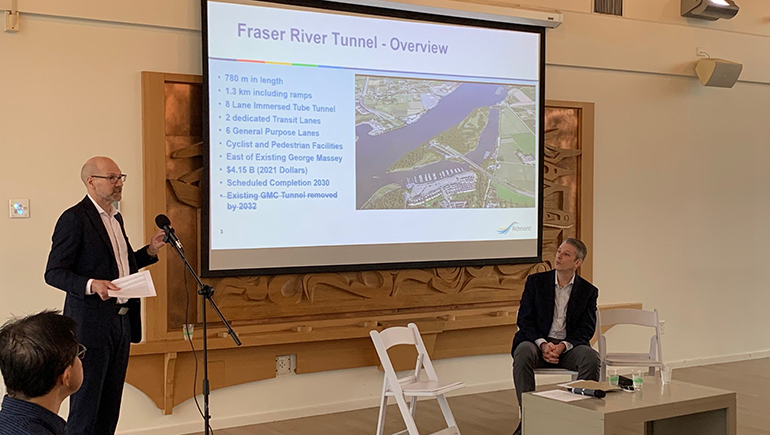Richmond 2024 Municipal update covered community plan, tunnel replacement
At a glance (4 minute read)
- Richmond faces significant population growth, necessitating 40,000 new housing units by 2041, with a focus on housing affordability, social equity, and environmental concerns.
- New provincial legislation (Bills 44, 46, 47) affects Richmond's planning framework, raising concerns about affordability and local context considerations.
- Projects include the Fraser River Tunnel replacement by 2030 with eight lanes, transit lanes, and cycling facilities, costing $4.15 billion, and the Steveston interchange project by 2025 costing $87.5 million.

Richmond continues to have one of the fastest growing populations in Greater Vancouver, now ranking fourth in total residents after Vancouver, Surrey, and Burnaby.
The next 30 years will be marked by a range of challenges such as the impacts of climate change, environmental quality, energy reduction, food insecurity, and an aging population.
With more than 80,000 new residents expected by 2041, approximately 40,000 new housing units will be needed.
Two Richmond planners summarized what's been happening in Richmond and what to expect in the coming years, for more than 70 REALTORS® at the municipal update on March 20, 2024.
Here's a summary of what they said.
John Hopkins, director of policy planning - Official Community Plan
There's a targeted review of Richmond’s Official Community Plan (OCP) with six target areas:
- Housing affordability.
- Social equity.
- Environmental protection and enhancement.
- Climate mitigation and adaptation.
- Emerging trends and technology.
- Administrative updates.
New provincial housing legislation, with significant changes to the planning framework, passed in 2023, is affecting the city.
- Bill 44 (small scale, multi-unit housing)
- Bill 46 (development financing)
- Bill 47 (Transit Oriented Areas)
Some immediate concerns with the legislation are:
- It doesn’t directly address housing affordability.
- It takes a “one size fits all” approach that doesn’t take account of local context, for example, floodplains or a lack of rear lanes.
Bill 44 requires all single-family/duplex zones to allow:
- three units per lot if the lot is less than 28 sq. m (3,014 sq. ft);
- four units per lot if the lot is greater than 280 sq. m (3,014 sq. ft); and
- six units per lot if the lot is close to transit stops with frequent service, which zoning must not require off-street parking or loading for any of the residential uses on the lot.
Bill 46 includes changes to municipal financing:
- opportunities to collect Development Cost Charges on new infrastructure categories; and
- creating an Amenity Cost Charge bylaw for specifically defined community amenities (for example, fire halls). This will help to pay for the costs of new development.
Bill 47 includes provisions for Transit Oriented development:
- aims to enable minimum residential densities for Canada Line stations (not including the Sea Island stations) when making zoning decisions as defined below:
- within 200 m of a Canada Line station: 5.0 Floor Area Ratio (FAR) and 20 storeys;
- 201 – 400 m of a Canada Line station: 4.0 FAR and 12 storeys;
- 401– 800 m of a Canada Line station: 3.0 FAR and 8 storeys; and
- remove residential parking minimums.
Deadlines
Richmond has set the following deadlines for required decisions and reports:
June 30, 2024
- adopt a zoning bylaw amendment or bylaws that comply with Bill 44, including amendments to parking bylaw (no public hearing required); and
- adopt a bylaw amendment to comply with Bill 47 that incorporates the minimum densities allowed near the Canada Line stations.
January 1, 2025
- Interim Housing Needs Report (20-year total number of housing units).
December 31, 2025
- Updated OCP and Zoning Bylaws to provide for 20-year housing needs.
View John Hopkin’s presentation (opens 13-page PDF).

Lloyd Bie, director transportation – Fraser River Tunnel Update 2024
The new tunnel, once completed in 2030, will be located east of the existing George Massey tunnel, 780 metres in length or 1.3 kilometres (including ramps), and will include:
- eight lanes in an immersed tube tunnel;
- two dedicated transit lanes;
- six general purpose lanes; and
- cyclist and pedestrian facilities.
The estimated cost is $4.15 billion (2021 dollars).
The Ministry of Transportation and Infrastructure is indicating the ends of the existing tunnel will be removed and the sections in the middle will be filled with sand or some other medium and abandoned.
The Steveston interchange project
This project at the intersection of Steveston Highway and Highway 99, once completed in 2025, will include:
- five general purpose lanes; and
- pedestrian and cycling facilities.
The design/build contractor is Flatiron and the estimate cost is $87.5 million (2021 dollars).
View Lloyd Bie’s presentation (opens 11-page PDF).
If you have questions about this update, contact Harriet Permut, director of government relations at hpermut@gvrealtors.ca.